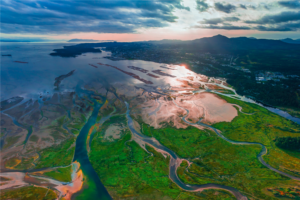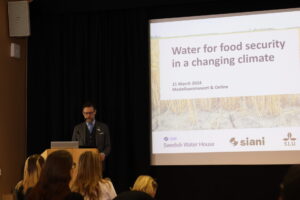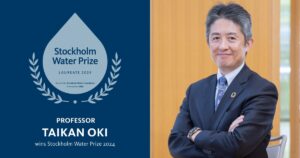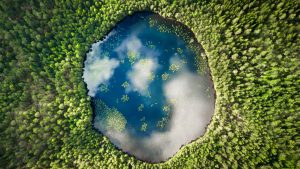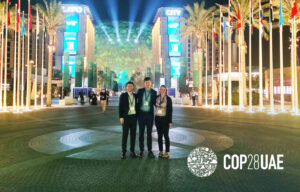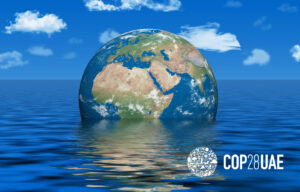- SIWI – Leading expert in water governance
- /
- Latest
- /
- Ma Jun to speak at Water Day
Ma Jun to speak at Water Day

Few people have followed environmental issues in China for as long and with such fervour as Ma Jun. Already in the 1990s, his investigative articles in the South China Morning Post, on topics like water quality and air pollution, attracted widespread attention. His 1999 book China’s Water Crisis is said to have stirred the Chinese into action much like Rachel Carson’s Silent Spring sparked American environmental awareness in the 1960s.
Ma Jun had travelled across China to collect information for the book and was struck by the water pollution and the suffering of local communities that he saw. But after the book was published, he also started to notice a new interest in environmental issues, with people all over the country asking what could be done.
“I began to realize that a problem of such a magnitude and complexity can’t be solved without extensive public participation. But that also requires access to information. With that in mind, I set up the Institute of Public and Environmental Affairs, IPE, and started working on transparency issues. I believe this is key to changing human behaviour,” Ma Jun says when describing how it all began.
Today IPE collects data and creates indexes to ensure maximum transparency about for example water pollution and air quality. The fact that companies, NGOs, investors, government officials and local communities now have access to the same information has led to drastic cuts in emissions.
If you compare the water quality situation today to 20 years ago, when your book was published, what has changed?
Things have changed quite a bit. We’re still facing many challenges that need to be addressed but there has been major progress. Compared to 20 years ago, public awareness is higher. At that time, few people payed attention to the water problem. If you would have stopped an average person in the street, they would have said that China needs to develop first, before thinking about the environment. Today, this has totally changed and in line with that, we can see changes in policy.
I remember how, when I wrote the book, engineers would talk about how the drying up of the Yellow River was actually a good thing, since it meant it that every drop of water was put to effective use. Today the slogan is instead to “maintain the river’s healthy life”. So, you can see a real change.
You started the Institute of Public and Environmental Affairs in 2006, how has it evolved?
The idea was to encourage transparency to bring about change. Our first project was “The China Water Pollution Map”, with water quality data, discharge data and performance records of dischargers. It was small, in 2006 we could only file 2,000 records of unlawful discharge into water bodies. Today, we have collected 1.5 million corporate violation records, half of which are related to water. We now have 22,000 monitoring stations, most of them official, and we try to develop our index. Every year we bring that information to the People’s Congress, to encourage more disclosures, and this has led to an increase in water data.
We have developed several different indexes, for example the Corporation Information Transparency Index, which encourages brands to be transparent and disclose data about their whole supply-chains. That data is also used in an environmental credit risk tool that we have co-developed together with a consultancy firm, so that financial institutions can assess the environmental risks of millions of factories in China. Financial institutions often say that they don’t have the expertise to follow all the individual companies, but here they get the structured and analytical data they need.
What has been the result?
In the 1990s, when I did my research, it was difficult to get even the most basic information. Now we work with 18,000 factories that provide their emissions data every two hours. Most of them have water-related activities, including some of the largest dye houses, paper mills, chemical plants, as well as thousands of sewage plants and water facilities at industrial parks.
Everyone can get access to this information from our cell phone app and some are using it to report polluting factories. So far, more than 2,000 such violations have been addressed. We also communicate our results to the People’s Congress every year to encourage more transparency.
How do you work with companies?
In 2007, we launched the Green Choice Alliance, calling for major brands to improve their supply chains. China had become the factory of the world, but the waste got dumped in our backyard and caused a lot of contamination. We have also developed a Corporation Information Transparency Index, which assesses the supply-chains of 370 brands, primarily from the IT and textile sectors. With the information, companies can first respond to questions from NGOs and communities, and then proactively address their problems.
This year we presented a new tool, the Blue Eco Chain, with a set process for handling complaints. Companies that join the Blue Eco Chain may follow their suppliers’ environmental performance through our website and app. And when there is a deviation, everyone gets notified through the app. The company then has 10 days to take action and show how they address the problem.
Since its launch in 2018, we’ve had 20 suppliers responding to regulatory issues every day. The Blue Eco Chain is very easy to use, with automated processes, so that it can be used by companies that say that they lack the resources to follow up.
So, we’ve managed to change the behaviour at factories and we are glad to see that financial institutions start to use some of our data. But we still haven’t reached our ultimate goal – to change the behaviour of consumers.
What could be done to influence consumers?
We’re still thinking about how we should do that. In China people are always on their smartphones with super apps where you can do everything… If we can use that, for example through some kind of environmental rating on e-commerce platforms, that would be immensely powerful!
What would you like consumers to know?
I want them to understand that although gadgets and clothes may look similar, their environmental footprint could be totally different. While the top brands are moving towards more life-cycle management, some brands still have outrageous problems with their supply-chains. We would like consumers to be able to differentiate between different kinds of brands and vote with their feet.
With all the data we have, this is totally doable. If you’re interested in a specific brand or factory, you could get all the information about their environmental performance, with ratings so that you can compare them to others.
Would you like consumers to also shop less?
I believe that this would also check the over-consumption, which is a problem. It’s driven by continuously dropping prices of all these gadgets and fashion brands because the real environmental cost is externalized, as a consumer you don’t pay for it.
The first step is to drive companies to comply with rules and regulations. Next, they should apply standards to improve beyond that. If all costs are internalized, including energy and the mining of resources, products will become more expensive and people will shop less since they are cost sensitive. Some people will also consciously choose to buy less, when they learn more about how some goods are produced.
How interested are Chinese consumers in sustainability? They normally rank high in international surveys?
That’s not a surprise, Chinese consumers care deeply about sustainability issues, they worry both about the quality of products and about the environment. But at the same time, in our country people are generally quite cynical. They don’t quite trust all this talk or many labeling. To be honest, some labels are actually quite questionable.
This is the reason I believe in the power of data. Only a disruptive level of transparency can make people trust companies. Now you don’t need to just take the company’s word for it, you can go to this app and see with your own eyes what is going on. The reason we pushed for such an extreme level of openness is that in China this is the only way we can really get people on board.
Which challenges do you see for the future?
Increasingly, we now see how factories are moving out of China to other countries, with lower operating costs. Hopefully, some of the hard lessons we learned in China can be used so that we avoid making the same mistakes over again. We shouldn’t allow new countries to become safe havens of pollution. With all this new IT technology – sensors, networks and data chains – we really have a chance to do better this time. I would love to work with likeminded people in other countries who are interested in our work.


